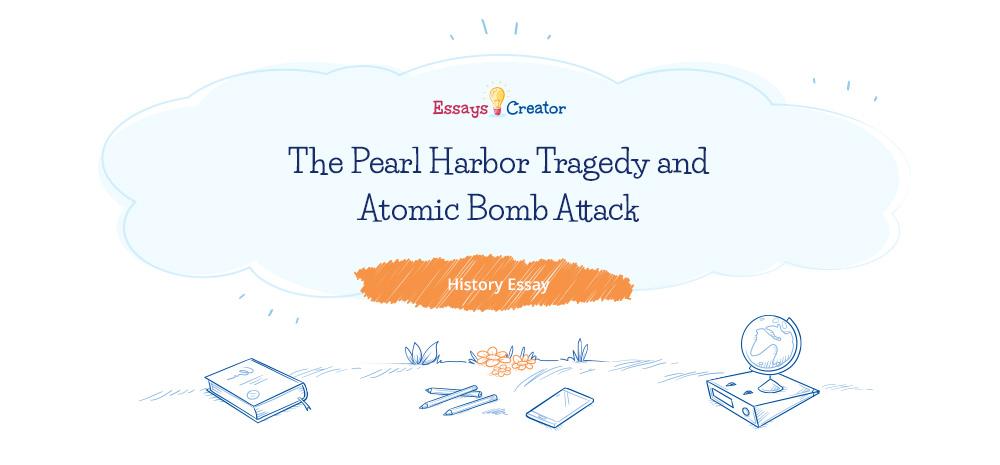
The Pearl Harbor Tragedy and Atomic Bomb Attack Free Essay
Pearl Harbor is a harbor on the island of Oahu, Hawaii. A decent part of the harbor and surrounding area is occupied by the central database of the United States Pacific Fleet. In 1875, the United States and the Kingdom of Hawaii signed a cooperation agreement under which the U.S. Navy had access to the harbor of Pearl Harbor in exchange for special conditions for the import of Hawaiian sugar into the United States.
Later, following the Spanish-American War of 1898, the U.S. finally annexed Hawaii. After the annexation of the harbor has been extended, making it possible to take more ships. On December 7, 1941, Japan attacked Pearl Harbor. It prompted the U.S. to enter World War II.
On November 26, 1941, the strike force of the Japanese Imperial Navy under the command of Vice-Admiral Nagumo Tyuiti by order of the Commander of the Navy Isoroku Yamamoto left the base in the Gulf Hitokappu in the Kuril Islands and headed for Pearl Harbor (Slackman, 1990). Americans expect the Japanese attacked the Philippines, but the Japanese hit Pearl Harbor.
There are several reasons why the Japanese attacked Pearl Harbor. After defeating the American Pacific Fleet, the Japanese hoped to prevent its interference in the conquest of the Dutch East Indies and Malaya. The Japanese hoped to gain time with Japan in the order could strengthen its position and increase its strength before it will make Americans. Finally, the attack delivered a severe blow to the morale of the Americans and kept them from entering the war in the western Pacific Ocean.
Order your History Essay help today!
Admiral Isoroku Yamamoto planned the attack on Pearl Harbor. He developed a plan that had to cause a sudden blow at the U.S. Navy. By mid-April 1941 plan Yamamoto was transferred to headquarters for consideration. Ministry of Foreign Affairs asked the Japanese consulate in Honolulu to put the location of each ship on the grid of Pearl Harbor. Tokyo received information about the movements of the fleet in and out of the bay. It knew about the exact location of each ship (Hamen, 2010).
Even though Americans guessed about the military plan of the Japanese, the mode of attack was unexpected for them. The Japanese force started its attack about at three o’clock. The attack began with the raid of the first echelon of the 183 Japanese planes. In one hour, it came to the second echelon with 171 planes. Each attack lasted about an hour. The consequences for the U.S. Navy were terrible. The result of the attack was the sinking of four U.S. Navy ships. The Japanese also destroyed or damage two auxiliary vessels, four battleships, three light cruisers, and two support ships. They destroyed 188 aircraft and killed approximately 3,000 people (Dan, 2004).
After the bombing attack on Pearl Harbor, President Roosevelt declared war on Japan. It forced the U.S. to enter World War II. The American soldiers were involved in the war for more than three years. When the war in Europe was over, the United States decided to bomb Japan with a nuclear weapon to cause it to surrender. The USA wanted to make emphasize its power and weapon that could destroy any city. The U.S. government wanted to show the whole world that it has the weapon of great destructive power. The atomic bombings of Japan are the only example of military use of nuclear weapons in the history of mankind. The U.S. forces carried out the final stage of World War II.
The first bomb was dropped on August 6, 1945. The aim was Hiroshima. To get the maximum effect, the Hiroshima bomb was detonated at an altitude of 580 meters. The shock wave reached the earth’s surface under the seat of the explosion. It spread to the nearby hills and returned to the city. The bomb was made with the use of radioactive uranium. The energy that was released in a bomb explosion in Hiroshima was equivalent to 12.5 kilotons of TNT. The explosion of a single atomic bomb that was applied in the port city of Hiroshima killed 140,000 people (Langley, 2006).
The second bomb that was aimed at Nagasaki was made from plutonium. It is believed that its capacity was approximately three times bigger than the power of the uranium bomb that was dropped on Hiroshima. The bomb’s size was 3.2 meters long. It has 1.5 meters in diameter and weighs – 4.5 tons. It exploded at an altitude of 500 meters above the city of Nagasaki on August 9, 1945. The result of the explosion was that 74,000 people died and 75,000 were injured. Nearly 90% of the population was killed within a radius of one kilometer from the explosion. The thermal radiation of the bombs caused extremely severe burns. The surface of the skin in the affected people completely burned, leading to exposure of tissues and organs (Langley, 2006). The two atomic bombs that were dropped by the U.S. forces made a huge impact on Japan’s authority. On August 15, 1945, Japan announced its surrender.
The role of the atomic bombings in Japan’s surrender and the ethical justification for the bombing itself is still controversial. The impact of this tragedy on the Japanese is still reflected in the health conditions of Japan’s residents. People are still suffering from injuries and diseases such as cancer and leukemia. Today, the death rate from diseases caused by radiation is more than 200 000 cases. From that time, many people died due to the direct or indirect effects of the U.S. bombing attack. Many victims suffer from synergistic effects and many physical injuries due to the radiation (Ishikawa, 1981)

